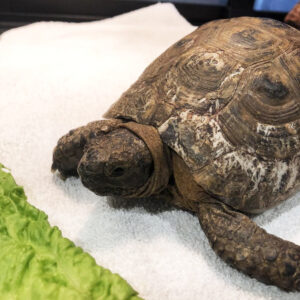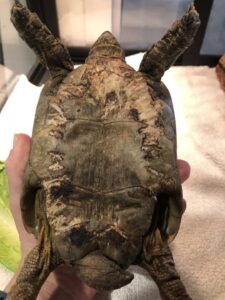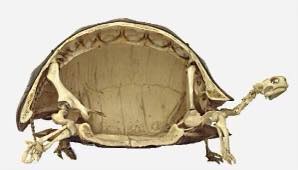7/28/2023 Officer Mullen reports…
Earlier this week, I was working at dispatch when I received a call from a concerned resident who was walking home from a park in the city when she saw a small tortoise on the side of the road. She noticed that the tortoise had some marks and abrasions on the shell and was concerned that the animal might be injured. She scooped up the tortoise, placed the animal in a box and gave me a call at dispatch. She was unsure if the animal she found was a native turtle or a domestic pet turtle. I gave her a phone number so she could text me a photo, so that I could identify the animal and assess whether it needed immediate care. I received her text and determined that this was a non-native species, likely someone’s escaped Russian or Greek pet tortoise that are known to dig out of outdoor enclosures and go on long adventures. The scars and marks on the shell looked to be healed trauma, so I spoke with the resident and gave her an update. We discussed that there was no immediate concern for injury and that she could bring the animal to the shelter at her convenience.
At the shelter we can provide some much-needed proper husbandry for this tortoise, such as correct lighting, soaking and proper diet while trying to locate the owner. Once the tortoise got to the shelter, she was identified as a Greek tortoise who was probably a female. Truly determining a tortoise’s sex and age can be difficult, but our best guess is that this is a very mature female Greek tortoise who seems to have been living on her own in the wilds of San Francisco for quite some time. Her shell has some damage, but the injuries seem to be older and all have healed. She was quite dry when she came in and has enjoyed her nice warm water soaks that help to rehydrate her body and stimulate movement of the GI system. She seems to be settling into her new digs in the shelter and I even got her to eat a little endive and Swiss chard snack.
As pets, Greek tortoises have been known to live up to 100 years old and many tortoises remain in the same family of caretakers and are passed down from one generation to the next. Tortoises are a big responsibility to take on as pets, but can be quite interactive and bond closely to their human caretakers. A tortoise shell is a very complex system of over 60 interconnected bones. The shell does not cover the tortoise, the shell is a part of the tortoise. These animals make a hissing noise as the head is retracted into the shell, this releases all of the oxygen from their lungs and they can hold their breath for up to 2 hours. This gives them a great defense from a wide variety of predators. As we noticed in this female Greek tortoise’s injuries, something must have chewed on her, but her shell kept her well protected.
Please always be on the lookout for any sick, injured or sometimes just out-of-place wildlife in San Francisco. Get in contact with our dispatch at 415-554-9400 and we will ask you a few questions about what you are seeing to help us determine the care needed for each situation. Thank you for helping us care for the many animals of San Francisco.




